Concrete Ehnhancement: How to Warm and Brighten Those Cold, Gray Floors

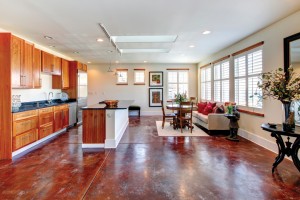 Historically, the only design choice associated with a concrete floor in the home was how best to cover it up: carpet, wood, tile or vinyl? No longer. Bare concrete has become a popular flooring option as homeowners turn to new decorative concrete materials, techniques and processes to brighten and animate their unfinished basements and other inside spaces.
Historically, the only design choice associated with a concrete floor in the home was how best to cover it up: carpet, wood, tile or vinyl? No longer. Bare concrete has become a popular flooring option as homeowners turn to new decorative concrete materials, techniques and processes to brighten and animate their unfinished basements and other inside spaces.
Their choices include acid-staining the concrete, marbling it with warm or vibrant metallic coatings, scoring, sawing and stamping it to achieve all manner of patterns and artistic expression, and smoothing and polishing it to a glossy, mirror-like sheen.
“With any kind of interior decorative concrete style, you get this beautiful, warm, finished floor that is easy to clean and maintain, and is allergy-free,” says Tim Seay, owner of Decorative Concrete of Virginia in Lynchburg. “A lot of people haven’t known that it’s an option, but the more decorative concrete floors we put in, the more calls we get for it. Other people see it and they want it too.”
In fact, the trend is becoming so prevalent that it’s not just for current homeowners who want a waterproof but inspired flooring solution in their basements. Decorative concrete is increasingly being used in new home construction.
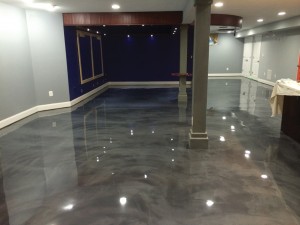 And this floor choice is not relegated to basements. If your house is built on a slab foundation, decorative concrete is a practical but beautiful choice for kitchens, baths, foyers, living rooms and closed-in porches. And if you have wood subflooring? It’s still an option, though maybe not an ideal one. Installers can trawl a layer of concrete over wood and jazz it up with decorative processes. However, since wood is pliable, this type of concrete floor is even more prone to crack and not something Seay or other installers usually recommend.
And this floor choice is not relegated to basements. If your house is built on a slab foundation, decorative concrete is a practical but beautiful choice for kitchens, baths, foyers, living rooms and closed-in porches. And if you have wood subflooring? It’s still an option, though maybe not an ideal one. Installers can trawl a layer of concrete over wood and jazz it up with decorative processes. However, since wood is pliable, this type of concrete floor is even more prone to crack and not something Seay or other installers usually recommend.
Colorful Options
For most homeowners, decorative concrete is an affordable way to give new life to old floors—and also create a unique look. And you don’t need to start from scratch or have perfect floors to get amazing results.
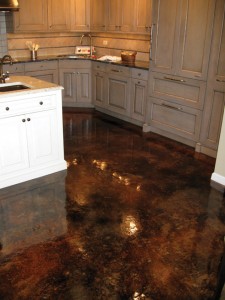 “A lot of people think that because they have carpet or vinyl installed already or because their concrete has a lot of cracks that they don’t have any options with decorative concrete,” says Seay. “But really, no matter what’s on the floor or even if the concrete isn’t smooth or has a lot of cracks in it, we can work with them to get a new look.”
“A lot of people think that because they have carpet or vinyl installed already or because their concrete has a lot of cracks that they don’t have any options with decorative concrete,” says Seay. “But really, no matter what’s on the floor or even if the concrete isn’t smooth or has a lot of cracks in it, we can work with them to get a new look.”
In fact, many homeowners first learn about stained concrete after a basement flood, leak or mold problem forces them to call in a specialist to rip out old carpet or wood and grind the original floor to remove old glue or paint. “Once we get it back down to bare concrete, we can do anything the homeowner wants,” Seay explains.
The simplest—and most cost-effective—option is acid-staining, which at $3 to $4 per square foot installed, is comparable to the price of average carpet and costs considerably less than wood
or tile.
To achieve the look, installers use a high-grade stain product that deeply penetrates the concrete and chemically changes the color. After letting it dry overnight, they seal the color first with a layer of professional-grade epoxy and then a layer of polyurethane, achieving a warm, rich floor that plays up the mottled tones and shades inherent in poured concrete.
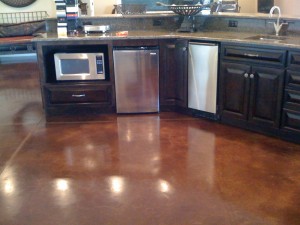 The color palette available with stained concrete is limited to warm earth tones, so homeowners who want a brighter, more primary coloring on their floors, including white, will need a metallic epoxy finish. This coloring technique, which generally costs between $5 and $7 per square foot, relies on an epoxy coating mixed with pigment and metal chips. The result? A marbled, semi-transparent appearance with more dimension and depth than a stained floor.
The color palette available with stained concrete is limited to warm earth tones, so homeowners who want a brighter, more primary coloring on their floors, including white, will need a metallic epoxy finish. This coloring technique, which generally costs between $5 and $7 per square foot, relies on an epoxy coating mixed with pigment and metal chips. The result? A marbled, semi-transparent appearance with more dimension and depth than a stained floor.
Floor Art
When combined with professional techniques like sawing, scoring, stamping and engraving, these two coloring processes can help homeowners turn their concrete floors into glossy works of art. The possibilities for an imaginative, conversation-sparking floor design are endless: irregular patterns, circular lines, geometric grids, and multi-color motifs. Some homeowners have even fashioned an original design, monogram or family crest in the center of a floor.
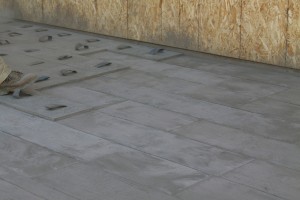 You can also go with a more traditional look. Installers can create a faux-tiled floor by trawling an overlay of concrete onto existing concrete floors (or even wood subfloors), scoring or stamping the desired pattern and then individually coloring each block with acid-stain or metallic epoxy. These types of techniques can also be used to imitate other popular floor choices like wood, stone, slate, granite and brick.
You can also go with a more traditional look. Installers can create a faux-tiled floor by trawling an overlay of concrete onto existing concrete floors (or even wood subfloors), scoring or stamping the desired pattern and then individually coloring each block with acid-stain or metallic epoxy. These types of techniques can also be used to imitate other popular floor choices like wood, stone, slate, granite and brick.
The benefits? You get the unique appearance, but not the shortcomings, of those options. You don’t have to worry about water damage like swelling, buckling and rotting. You don’t have to purchase higher-priced specialty cleaners, as concrete floors can be wiped clean with a mop and soapy water. And the surface is as impervious as a floor can be to scratches and scuffs from toys, pets and high heels.
The one downside to concrete has always been that cracks can and do occur due to shrinkage. However, with decorative concrete techniques, these cracks are no longer an eyesore.
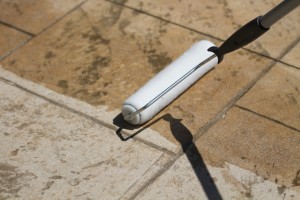 For example, an older floor with numerous cracks or uneven spots can be smoothed over with a trawled concrete overlay (which actually makes the floor even harder) and then stained or colored and sealed. If the floor has one or a few cracks and you’re planning to use metallic epoxy, installers can use a saw or scoring tool to build color or an irregular pattern around the crack to help camouflage it.
For example, an older floor with numerous cracks or uneven spots can be smoothed over with a trawled concrete overlay (which actually makes the floor even harder) and then stained or colored and sealed. If the floor has one or a few cracks and you’re planning to use metallic epoxy, installers can use a saw or scoring tool to build color or an irregular pattern around the crack to help camouflage it.
Really, though, there’s no need to try and hide the imperfections, Seay says. “Most of the time a crack will suck up more color than the rest of the floor, so the crack actually accentuates the color and gives it a natural look,” he explains. “It doesn’t look like a cracked floor, it just blends in and gives the floor some added character.”
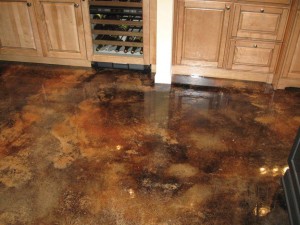 Finally, homeowners can give their concrete floors a final polish, with hardeners and diamond tooling used to achieve various levels of shine—from a matte finish to a wet look to a gloss so high that you can see your reflection in it.
Finally, homeowners can give their concrete floors a final polish, with hardeners and diamond tooling used to achieve various levels of shine—from a matte finish to a wet look to a gloss so high that you can see your reflection in it.
No matter what decorative concrete color, style or finish you choose, you’ll reap all the same benefits: a one-of-a-kind, refined, durable, allergy-friendly and easily maintained floor that your visitors will never recognize as concrete.
Decorated Concrete, Decorative Concrete of Virginia, Faux-tiled Floor, Metallc Coatings, Metallic Epoxy, Stamping Concrete






